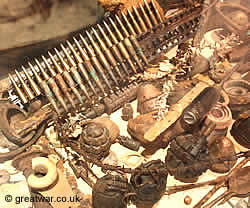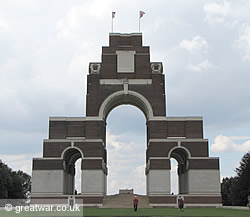36th (Ulster) Division Memorial, The Ulster Memorial Tower
The Ulster Memorial Tower is a Somme battlefield memorial to the men of the 36th (Ulster) Division. It commemorates the heavy losses suffered by 36th Division on 1st July 1916, the first day of the Battle of the Somme.
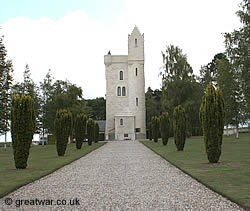
|
The soldiers of 36th Division left the British Front Line at the eastern end of Thiepval Wood, crossed No Man's Land and broke through the badly damaged German Front Line trench. They also captured the difficult obstacle of the large German stronghold at the Schwaben Redoubt just beyond the German Front Line. The redoubt was called Feste Schwaben by the German Army.
During the day the soldiers from Ulster did successfully manage to advance their position for about a mile (1,600 metres) beyond their starting positions, almost reaching the German field gun positions located in the valley leading to Grandcourt. Regrettably, due to the difficulty of supplying ammunition, equipment, food and water to the men in the forward positions, they had to fall back. German counterattacks from mid afternoon added to the danger that the forward Irish troops might be cut off. The position was considered untenable for the Irish soldiers by the end of the day and the decision was made to withdraw back to the German Front Line.
At the end of the day on 1st July the 36th (Ulster) Division had suffered over 4,900 casualties:
- 79 officers and 1,777 other ranks killed
- 102 officers and 2,626 other ranks wounded
- 7 officers and 206 other ranks missing
- 1 officer and 164 other ranks taken prisoner.
The photograph is taken from a point close to the entrance gate of the Ulster Memorial Tower on the D73, known as Mill Road on British Army maps. The Ulster Memorial Tower is behind and to the right of the photographer. The view looks across to the north bank of the Ancre River, showing the strategically important high ground gained by the Ulstermen during 1st July, which provided an advantageous view into the German rear areas east of Beaumont-Hamel.
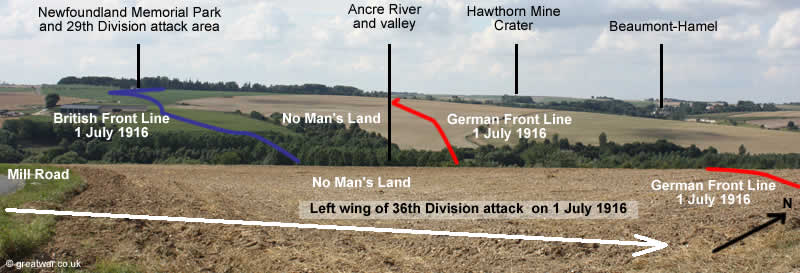
A Monument to Ulster's Soldiers
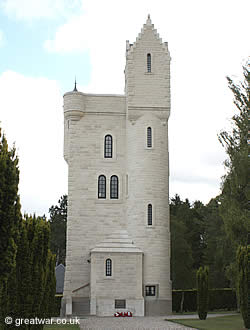
|
On 17th November 1919, a few days after the first anniversary of the Armistice of 11th November 1918, a meeting was held at the Old Town Hall in Belfast. Further to discussion about proposals for a memorial to be placed on the 1st July 1916 battlefield where so many Ulstermen had lost their lives, a decision was made to build a monument in the form of a well-known Ulster landmark. This was the suggestion of Sir James Craig. Two years later he was to become the first Prime Minister of Northern Ireland, holding that office from 1921 to 1940.
Helen's Tower in Clandboye near Belfast was selected as the most appropriate building to replicate for the monument on the 1916 Somme battlefields.
Helen's Tower, County Down
The Memorial Tower is a replica of the well-known tower in Ulster, Northern Ireland, called Helen's Tower. Helen's Tower is located on the Dufferin and Ava Estate at Clandeboye, County Down.
Helen's Tower was built by Lord Dufferin in 1867. He dedicated it to his mother, Baroness Dufferin, whose name was Helen. She was the grand-daughter of the Irish dramatist, poet and Member of Parliament Richard Brinsley Sheridan (1751-1816).
36th (Ulster) Division in Training
Helen's Tower was located in the centre of the training camp where the volunteer Ulstermen of the 36th Division began their training following the formation of this new division from late August 1914. Thousands of men from Ulster answered Lord Kitchener's call for volunteers at the outbreak of war in August 1914. Many of them were members of the Protestant organisation called the Ulster Volunteer Force. The three regiments in the 36th Division were:
- the Royal Inniskilling Fusiliers
- the Royal Irish Fusiliers
- the Royal Irish Rifles
In July 1915 36th (Ulster) Division left Northern Ireland for England, spending three months training in Sussex before departing for France in the first Week of October 1915. A view of Helen's Tower would have been one of the last things they would have seen as the they left the training camp in July 1915. Many hundreds of them would never return.
Construction of the Memorial Tower
The architects appointed to design the memorial tower were Messrs Bowden and Abbot of Craven Street in London. The construction of the Ulster Memorial Tower was carried out by Fenning and Company Ltd. of Hammersmith, London and the Société de Construction et Travaux Publics d'Arras.
The Memorial Tower measures 70 feet (approximately 21 metres) at its highest point.
The building comprises a Memorial Room, a flat for a caretaker to live in and access to the roof to provide visitors with a view across the battlefields. (Access to the roof for visitors is no longer allowed.)
Dedication of the Memorial Tower
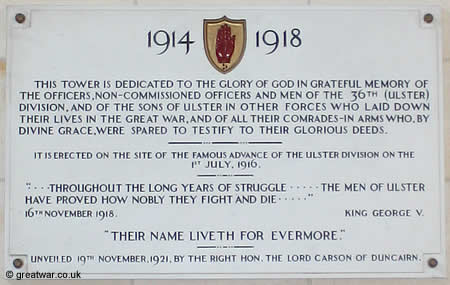
|
The Ulster Memorial Tower was one of the first official memorials to be put up on the Western Front.
The Ulster Memorial Tower was dedicated at a ceremony on Saturday 19th November 1921, almost exactly two years after the meeting at the Old Town Hall in Belfast decided to have such a monument on the battlefield. The memorial was unveiled by the Chief of the Imperial General Staff of the British Army, Field Marshal Sir Henry Wilson.
Sir Henry, born in Currygrane, County Longford, was appointed as the British Army's most senior officer as Chief of the Imperial General Staff in February 1918. He was a supporter of Irish Unionism. A few months after unveiling the Ulster Memorial Tower he was shot and killed outside his house in London in June 1922 by two members of the Irish Republican Army.
Memorial Room
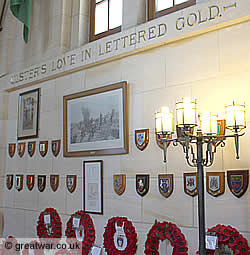
|
Inside the Tower there is a room which is 16 feet square. It is a Memorial Room with a Book of Remembrance for visitors to sign. On the walls there are plaques of remembrance from regiments and a wide variety of organisations and public authorities in Northern Ireland.
In the Memorial Room the marble tablet is inscribed with the words:
“This Tower is dedicated to the Glory of God, in grateful memory of the officers, non-commissioned officers and men of the 36th (Ulster) Division and of the sons of Ulster in other Forces who laid down their lives in the Great War, and of all their comrades-in-arms, who, by divine grace, were spared to testify to their glorious deeds.”
The following words are inscribed in gold lettering around the walls:
“Helen's Tower here I stand
Dominant over sea and land
Son's love built me and I hold
Ulster's love in lettered gold”

|
The words in gold were originally written by Alfred Lord Tennyson for an inscription in the original Helen's Tower in Clandeboye. The only change made to the words was that the original inscription read “Helen's love” in the last line, and this was changed to “Ulster's love” for the battlefield memorial tower.
Rededication of the Memorial, 1989
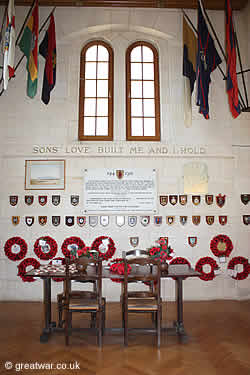
|
The Ulster Memorial Tower had been a place of pilgrimage for many thousands of Irish people since it was dedicated in 1921. However, by the late 1980s the tower was in need of refurbishment and did not have a resident caretaker. A cross community group called the Farset Somme Project successfully lobbied to have the memorial refurbished.
Work was carried out and the Tower was rededicated on 1st July 1989 in the presence of HRH Princess Alice, Duchess of Gloucester.
Visitor Centre
A Visitor Centre was opened next to the Tower in 1994. For information about the Visitor Centre and its facilities at the Ulster Memorial Tower (open March-November) see our page at:
Ulster Memorial Tower Visitor Centre
Memorial to all Ranks & VC Winners
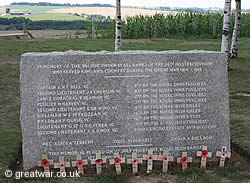
|
A memorial is located in the grounds of the Ulster Memorial Tower which was placed there on 1st July 1991 by the Royal Irish Rangers. The memorial is dedicated to all ranks of the 36th (Ulster) Division and inscribes the names and battalions of the nine officers and soldiers of the division who were awarded the highest British military decoration, the Victoria Cross, for their gallantry on the battlefield. The named VC winners of 36th Ulster Division are:
- Captain E N F Bell, VC, 9th Battalion the Royal Inniskilling Fusiliers
- Second Lieutenant J S Emerson, VC, 9th Battalion the Royal Inniskilling Fusiliers
- Lance Corporal E Seaman, VC, 2nd Battalion the Royal Inniskilling Fusiliers
- Fusilier N Harvey, VC, 1st Battalion the Royal Inniskilling Fusiliers
- Second Lieutenant E de Wind, VC, 15th Battalion The Royal Irish Rifles
- Rifleman W F McFadzean, VC, 14th Battalion The Royal Irish Rifles
- Rifleman R Quigg VC, 12th Battalion The Royal Irish Rifles
- Lieutenant G St. G S Cather, VC, 9th Battalion the Royal Irish Fusiliers
- Second Lieutenant C L Knox, VC, Royal Engineers (attached 36th Division)
The Orange Memorial to Fallen Brethren
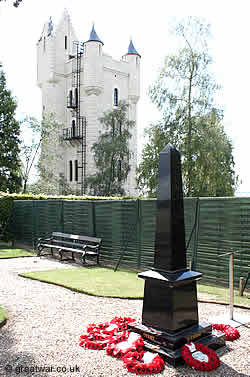
|
The memorial is dedicated to the men and women of the Orange Institution worldwide who served with the military forces in 1914-1918.
The memorial is located in the grounds of the Ulster Memorial Tower.
Location of the Ulster Memorial Tower
The Ulster Memorial Tower is located on the D73 on the brow of the hill between the railway line and Ancre River in the river valley and the hamlet of Thiepval.
Parking
There is a designated parking area off the road. Parking is free and there is room for several cars and one to two coaches at any one time.
Related Topics
The Somme Association
The Somme Association was founded to manage the Ulster Memorial Tower and the Visitor Centre following the refurbishment in the early 1990s.
For more information about the Somme Association, and how to join the “Friends of the Somme”, see our page at:
Monuments and Memorials on the Somme Battlefields
Monuments on the Somme Battlefields

